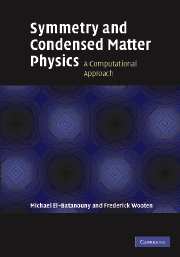Book contents
- Frontmatter
- Contents
- Preface
- 1 Symmetry and physics
- 2 Symmetry and group theory
- 3 Group representations: concepts
- 4 Group representations: formalism and methodology
- 5 Dixon's method for computing group characters
- 6 Group action and symmetry projection operators
- 7 Construction of the irreducible representations
- 8 Product groups and product representations
- 9 Induced representations
- 10 Crystallographic symmetry and space-groups
- 11 Space-groups: Irreps
- 12 Time-reversal symmetry: color groups and the Onsager relations
- 13 Tensors and tensor fields
- 14 Electronic properties of solids
- 15 Dynamical properties of molecules, solids, and surfaces
- 16 Experimental measurements and selection rules
- 17 Landau's theory of phase transitions
- 18 Incommensurate systems and quasi-crystals
- Bibliography
- References
- Index
13 - Tensors and tensor fields
Published online by Cambridge University Press: 06 July 2010
- Frontmatter
- Contents
- Preface
- 1 Symmetry and physics
- 2 Symmetry and group theory
- 3 Group representations: concepts
- 4 Group representations: formalism and methodology
- 5 Dixon's method for computing group characters
- 6 Group action and symmetry projection operators
- 7 Construction of the irreducible representations
- 8 Product groups and product representations
- 9 Induced representations
- 10 Crystallographic symmetry and space-groups
- 11 Space-groups: Irreps
- 12 Time-reversal symmetry: color groups and the Onsager relations
- 13 Tensors and tensor fields
- 14 Electronic properties of solids
- 15 Dynamical properties of molecules, solids, and surfaces
- 16 Experimental measurements and selection rules
- 17 Landau's theory of phase transitions
- 18 Incommensurate systems and quasi-crystals
- Bibliography
- References
- Index
Summary
Tensors and their space-time symmetries
Condensed matter systems have diverse physical properties that are described by tensorial quantities. By this we mean that physical properties of a system are usually defined by, and consist of, relationships between two or more particular measurable quantities associated with the system. These measurable quantities themselves usually assume tensorial forms, so that the ensuing physical properties that characterize a physical system are represented by tensors.
Scalars, i.e. tensors of rank 0, are typified by temperature, pressure, and mass of a homogeneous system, etc., while tensors of rank 1, i.e. vectorial properties, are manifest in electric and magnetic fields and moments, temperature gradients, and currents. Examples of second rank tensors are evident in the characterization of stress and strain in material systems. All these tensors describe either some physical state of a system or some externally applied physical field. For example, the magnitude and direction of the electric polarization is specified in response to an applied external electric field. We call all these tensors, both applied and induced, physical tensors.
We also encounter second and higher rank tensors that relate applied and induced physical tensors, for example, the electric susceptibility tensor of rank 2 connects the electric polarization with the applied electric fields, and the elasticity tensor, of rank 4, relates the strain to the applied stress. In contrast to physical tensors, the latter tensors are system specific: their particular forms, i.e. the number of linearly independent components and their values, are determined by the symmetry and structure of a given system. We refer to these system-specific tensors as matter, or material, tensors.
- Type
- Chapter
- Information
- Symmetry and Condensed Matter PhysicsA Computational Approach, pp. 474 - 551Publisher: Cambridge University PressPrint publication year: 2008



